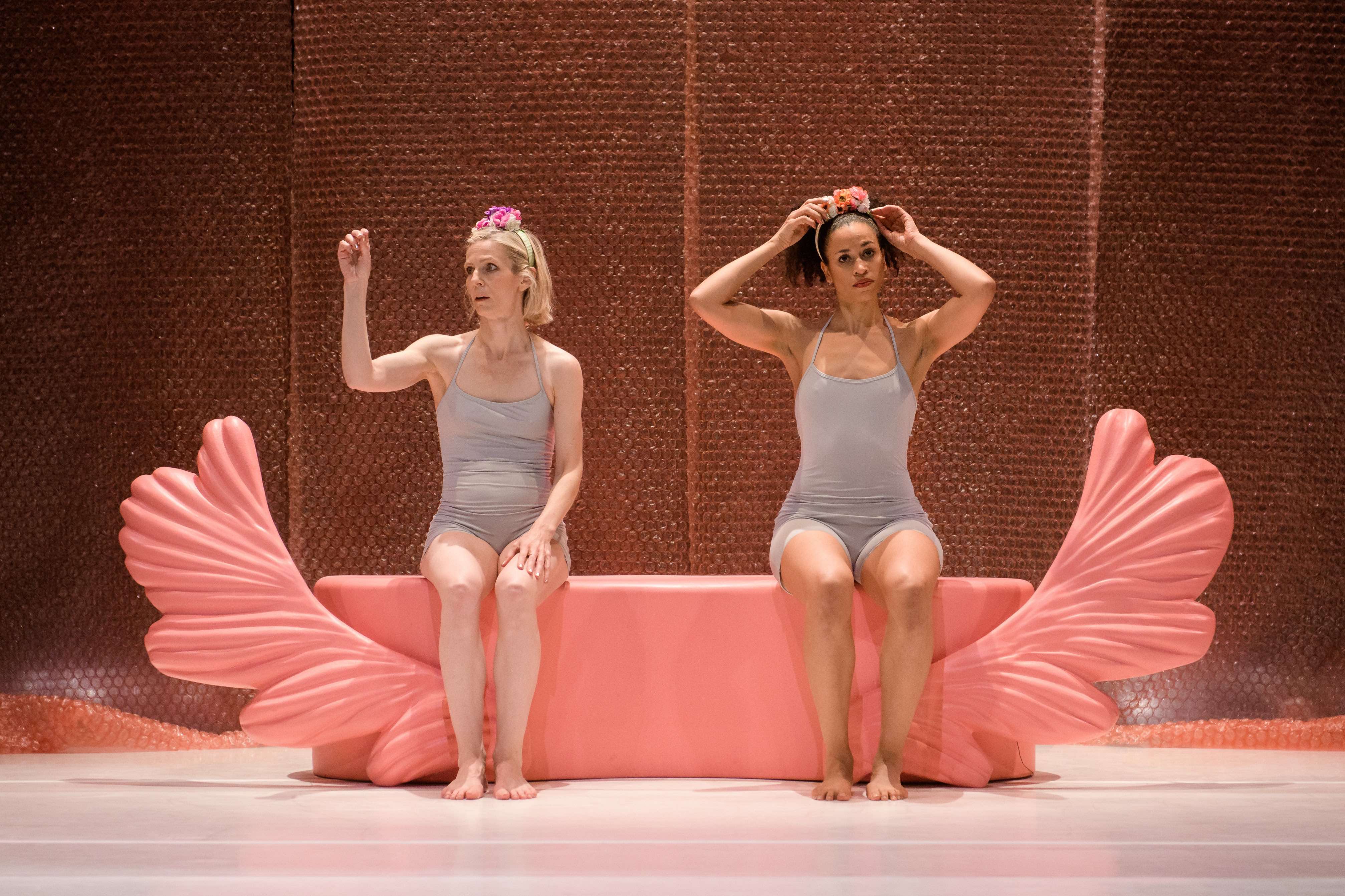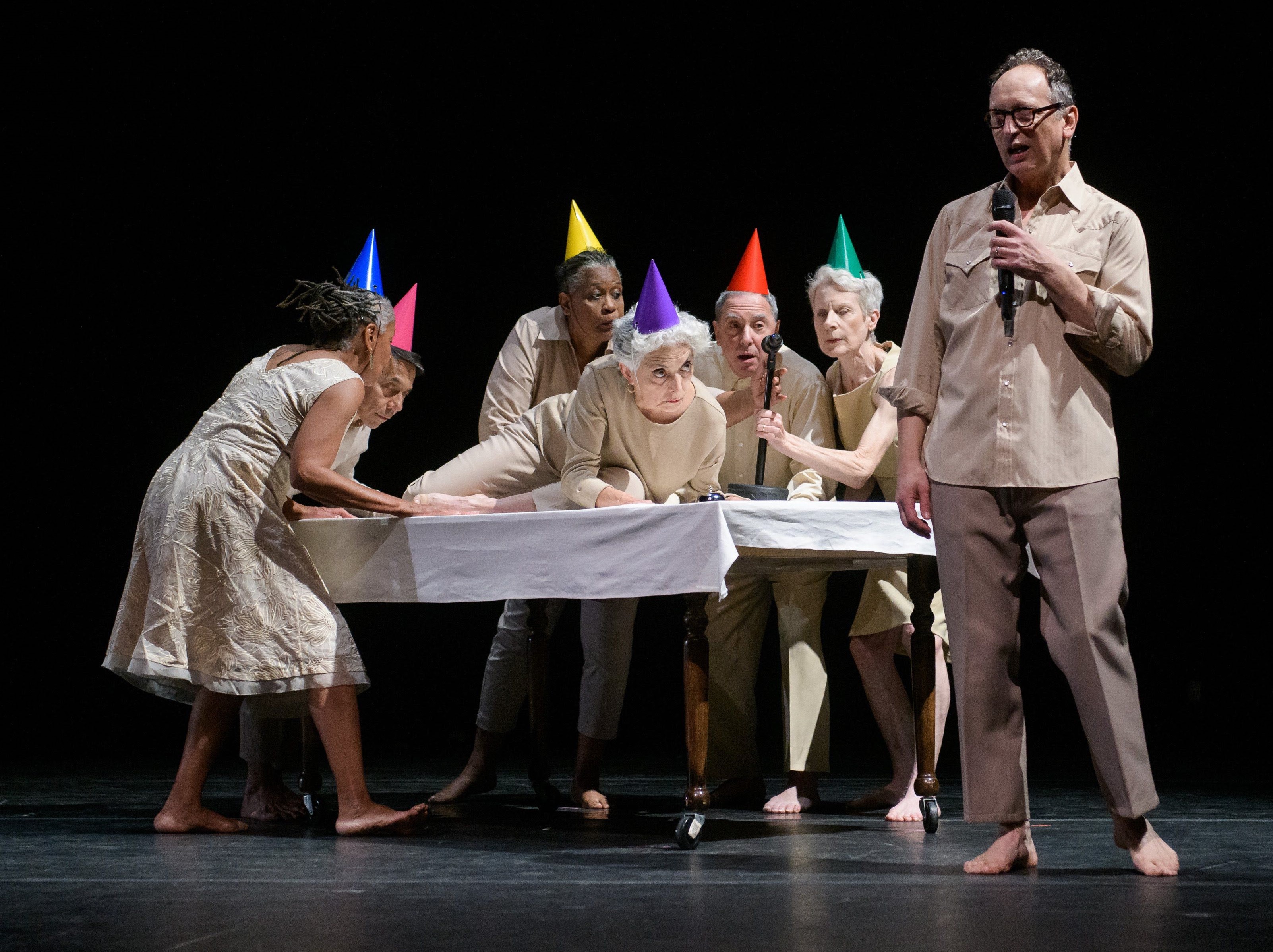Reviews
Navigating Big Dance Theater: A Challenge Worth the Effort
Annie-B Parson is the queen of gesture. The artistic director and co-founder of Big Dance Theater, she has an innate ability to layer seemingly random and pedestrian movements with textual references to create works that are at once funny, touching, and unfailingly clever. This skillset was on clear display in The Road Awaits Us, Big Dance Theater’s most recent show, which ran at NYU Skirball Center November 8-9.
Parson is known for weaving together disparate materials. But the beauty of Big Dance Theater is that, although advance knowledge of the subject matter may enrich the viewing experience, it’s never essential to enjoying it. The Skirball triple bill opened with the North American premiere of Parson’s ballet dance, the basis of which—ballet—is less obscure than many of Parson’s works, leaving fewer levels to excavate. Nevertheless, it’s a waggish take on classical ballet, and the ways it’s viewed in society today. 
Elizabeth Dement and Natasha Diamond-Walker in ballet dance
Danced by Elizabeth Dement and Natasha Diamond-Walker, ballet dance opens to an all-pink set. A large backdrop of bubble wrap frames an acrylic, winged bench. Both dancers wear gray unitards; they try on and discard costume elements throughout—children’s sized tutus, flowered headbands, skirts made of bubble wrap, etc. Combined with the seriousness with which they deliver Parson’s movement, their accessorizing looks silly, a comment on the rose-colored lens through which young girls view ballet. Projected images of pixelated, psychedelic looking roses add to the effect.
The choreography intersperses unaffected ballet poses with Parsonian gesture: a tendu is broken with a flexed foot; hands are clapped twice on each side of the face. Dement and Diamond-Walker break to sit side by side on the bench and enter into a deadpan discussion about ordering food. Though the content comes from the defunct podcast Shut Up, Weirdo (“Just two girls. Having a good time. On a Friday night”), it could just as easily be an after-dance-class conversation between two friends. They incorporate gesture naturally, as if translating into a secret sign language as they speak.
The second source for ballet dance is John Haskell’s 2017 hybrid of criticism and fiction, A Complete Ballet. A recording of Parson reading the book’s section on La Sylphide plays as the dancers go through deconstructed Sylphide-esque movements with deconstructed costumes to boot: Diamond-Walker, as the Scottish James, wears a strip of plaid fabric hanging from her waist, and Dement, as the Sylph, wears a pink tulle skirt and a hat with earflaps. In the ballet’s plot, James ultimately kills his beloved by wrapping her in an enchanted scarf; this seems to account for Parson’s choice of a hat. A computer-generated voice continues reading from Haskell, mispronouncing key French words (pas de chat, Balanchine) along the way. But the piece’s ending is abrupt, and feels unfinished.
A lesson in John Cage
Paul Lazar, Big Dance Theater co-founder and Parson’s partner, entered in front of the just-closed curtain at the end of ballet dance for his Cage Shuffle: redux. Barefoot in jeans, a t-shirt, and a blazer, he struck up a casual, one-sided conversation with the audience, explaining what was about to happen: A randomly ordered collection of stories from John Cage’s 1963 score Indeterminacy would be piped into his ear. He’d repeat the stories aloud, all while doing a dance choreographed by Parson that would remain unchanging, regardless of the stories’ order. It’s a brilliant play on the uber-seriousness of postmodern dance and music, at once honoring and lightly poking fun at these forms.
Varying tempi are built into the score—Cage timed each story to a single minute, meaning they’re either spoken slowly with long pauses or sped through comically—which lends a natural rhythm to the piece. Parson’s dance is a long phrase of discrete gestures. Lazar, an actor, doesn’t move like a dancer, and his stilted movements show effort in a way that’s delightfully human. The confluence between the dance and the text is often funny, and Lazar chuckles along with the audience. The piece ends with a spontaneous coda to a disco version of Ethel Merman singing There’s No Business like Show Business, which Lazar wraps up by announcing intermission.
The second half of the program was dedicated to the North American premiere of The Road Awaits Us, which Parson created in 2017 for the London-based KnowBody II, a company of older artists. She’s recast it here with a group of nine established performers. The piece is about aging. While this isn’t the sexiest topic for the dance stage, Parson pulls it off with remarkable aplomb.
The Road pulls content from two plays: Eugene Ionesco’s The Bald Soprano and Anton Chekhov’s The Cherry Orchard. Much of The Road involves setting up short quotidian scenes, narrated by Lazar, who also co-directed the piece. In transitional moments, the performers prance off in pairs, knees raised high. They wear regular clothes in washed out shades of cream and tan, seemingly referencing the erasure of the elderly in society, with brightly colored paper birthday hats. The only other splash of color onstage comes from a silver platter covered in fake fruit. Much of the piece reads as a fantastically absurd look at the little things that take up our time: setting the table for dinner, answering the door, reading nighttime stories, talking about the neighbors. But it’s the ending of The Road that is truly sublime.
 A scene from Annie-B's The Road Awaits
A scene from Annie-B's The Road Awaits
After a singalong to Queen’s “Hammer to Fall,” the group reenters with jackets on over their costumes and sits, legs dangling, on the lip of the stage. As looping, melancholic music plays, Lazar holds a microphone up to each dancer, signaling their turn to speak. He also includes the audience—when he points the microphone toward the house, everyone speaks words projected on the back wall. The Chekhovian phrases are simple but terribly sad: “In one hundred years, no one will remember us.” “We must be going.” “Goodbye, dear house.” Then Sheryl Sutton stands up and slowly walks upstage. She pulls open a large sliding door in the bare back wall, exposing a small room holding a table laid with a white cloth and decorated with colorful balloons and streamers. One by one, the rest of the cast follows. Those remaining repeat the titular line twice, “The road awaits us,” and then rise and begin a contemplative dance, led by the ever-graceful Keith Sabado.
As the lights onstage fade, the back room grows brighter. As each performer enters, they’re greeted warmly, and welcomed into a card game around the table. It’s chill-inducing. With The Road, Parson has outdone herself; it’s a sublime, serene, and joyful celebration of aging, and an unprecedented homage to the bittersweet melancholia that comes with looking toward the end of life.





 FEATURED JOBS
FEATURED JOBS

 RENT A PHOTO
RENT A PHOTO


